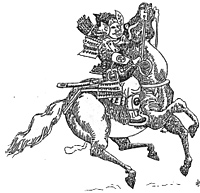9. Weather
 With weather playing an important part in many samurai battles such as the snow-covered battlefield of Mikata-Ga-Hara, 1572 or the thunderstorm during Okehazama, 1560, it only seems right to let the weather have some influence on our battles.
With weather playing an important part in many samurai battles such as the snow-covered battlefield of Mikata-Ga-Hara, 1572 or the thunderstorm during Okehazama, 1560, it only seems right to let the weather have some influence on our battles.
When not playing a scenario or campaign game, roll 1d6 on the Weather chart before the first turn to determine the season. At the start of the game assume the weather is fine but roll 2d6 on the weather chart at the beginning of each turn to see if there is a change, before rolling for initiative.
| Weather | Season | ||
|---|---|---|---|
| Spring/Autumn | Summer | Winter | |
| Die Roll | 1-3 | 4-5 | 6 |
| 2-8 | Fine | Fine | Fine |
| 9 | Fine | Fine | Light Rain |
| 10 | Light Rain | Fine | Fog |
| 11 | Fog | Light Rain | Heavy Rain |
| 12 | Heavy Rain | Thunderstorm | Snowing |
If there is a change in the weather, consult the weather effect table to determine the effects on the battle. At the beginning of each subsequent turn, roll 1d6 (-1 from die in Winter) to see if the poor weather clears. On a roll of 3 or less the poor weather persists – roll again next turn. A result of 4+ means that the weather is once again fine.
| Weather | Effect on Visibility | Effect on Movement | Effect on Combat |
|---|---|---|---|
| Fine | None | None | None |
| Light Rain | None | None | Firing : Arquebus -1 |
| Heavy Rain | 30cm | All moves –3cm | Firing : Bows -1, Arquebus -2 |
| Thunderstorm | 25cm | As Heavy Rain but no artillery movement except to rotate | Firing : Bows -2, No Arquebus Melee : No charge bonus |
| Snowing | 20cm | All moves halved. No artillery movement except to rotate | Firing : Bows -1, Arquebus -2 Melee : No charge bonus |
| Fog | 10cm | None (but note command radius = 10cm) | None (but range limited to 10cm) |
10. Winning and Losing
At the end of each turn, check for Victory. It is often obvious who has won, or is about to win, a battle. However, here is a simple definition for one-off games. A side loses the battle when it has lost more than 1/3 of its units, but ignoring peasants and counting hatamoto as 2 units and headquarters as 3 units. Although not directly affecting the outcome, the player who killed the most enemy leaders through challenges can boast about his great deeds in the pub afterwards!
Daimyo Samurai Wargames Rules 1550-1615
Back to Table of Contents -- Lone Warrior # 144
Back to Lone Warrior List of Issues
Back to MagWeb Magazine List
© Copyright 2003 by Solo Wargamers Association.
This article appears in MagWeb (Magazine Web) on the Internet World Wide Web.
Other articles from military history and related magazines are available at http://www.magweb.com
